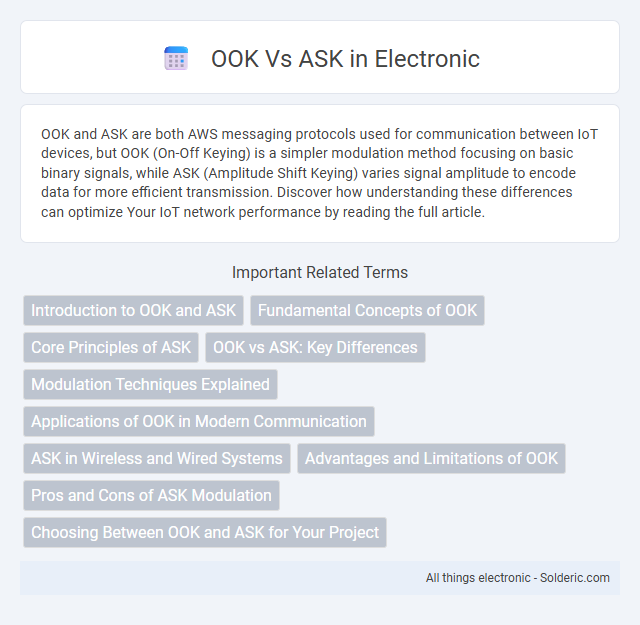OOK and ASK are both AWS messaging protocols used for communication between IoT devices, but OOK (On-Off Keying) is a simpler modulation method focusing on basic binary signals, while ASK (Amplitude Shift Keying) varies signal amplitude to encode data for more efficient transmission. Discover how understanding these differences can optimize Your IoT network performance by reading the full article.
Comparison Table
| Feature | OOK (On-Off Keying) | ASK (Amplitude Shift Keying) |
|---|---|---|
| Modulation Type | Binary amplitude modulation (signal presence or absence) | Amplitude modulation with multiple amplitude levels |
| Signal States | Two states: ON (1) and OFF (0) | Two or more states depending on levels |
| Bandwidth Efficiency | Less bandwidth efficient | More bandwidth efficient than OOK |
| Complexity | Simple transmitter and receiver design | Moderate complexity due to amplitude detection |
| Power Consumption | Lower power in idle state (signal off) | Constant power consumption |
| Noise Susceptibility | More susceptible to noise and interference | Less susceptible than OOK, better noise performance |
| Applications | Simple RF communication, remote controls, RFID | Digital communication over optical and RF channels |
Introduction to OOK and ASK
On-Off Keying (OOK) is a modulation technique where the presence or absence of a carrier signal represents digital data, commonly used in low-power and simple communication systems. Amplitude Shift Keying (ASK) varies the amplitude of the carrier wave to convey information, offering higher spectral efficiency compared to OOK. Both methods play crucial roles in wireless communication, with ASK enabling more complex amplitude variations and OOK providing straightforward implementation.
Fundamental Concepts of OOK
On-Off Keying (OOK) is a form of Amplitude Shift Keying (ASK) where the presence of a carrier wave represents a binary one, and its absence denotes a binary zero, enabling simple digital modulation for communication systems. OOK is widely used in optical communications and low-power wireless transmissions due to its straightforward implementation and efficient usage of bandwidth. The fundamental concept involves turning the carrier signal on and off to transmit data, which contrasts with other modulation schemes that vary amplitude, frequency, or phase continuously.
Core Principles of ASK
Amplitude Shift Keying (ASK) operates by varying the amplitude of a carrier signal to represent digital data, typically using two amplitude levels for binary communication. Unlike On-Off Keying (OOK), which is a specific form of ASK where one amplitude level is zero (the signal is turned off), ASK allows multiple amplitude levels for multilevel signaling, enhancing data transmission rates. This modulation technique is widely used in optical and radio frequency communication systems due to its simplicity and ease of implementation.
OOK vs ASK: Key Differences
OOK (On-Off Keying) and ASK (Amplitude Shift Keying) are both modulation schemes used in digital communication but differ primarily in signal representation. OOK transmits data by switching the carrier wave on and off to represent binary states, while ASK varies the amplitude of the carrier signal to convey information. The key difference lies in OOK being a specific form of ASK with two amplitude levels--presence or absence of the carrier--making OOK simpler and often more power-efficient, whereas ASK encompasses multiple amplitude levels for increased data rates.
Modulation Techniques Explained
On-Off Keying (OOK) and Amplitude Shift Keying (ASK) are modulation techniques used for encoding digital signals by varying the amplitude of a carrier wave. OOK is a specific form of ASK where the presence or absence of the carrier wave represents binary data, typically "1" or "0," making it a simple and energy-efficient modulation method. ASK modulates digital data by varying the amplitude between predefined levels, enabling transmission of multiple bits per symbol in more complex systems.
Applications of OOK in Modern Communication
OOK (On-Off Keying) is widely used in optical communication systems, such as fiber-optic networks and low-power infrared transmissions, due to its simplicity and energy efficiency. Applications of OOK include remote controls, RFID systems, and short-range wireless communication like Li-Fi, where rapid switching between light pulses ensures clear data transmission. Your modern communication setup benefits from OOK's robustness in noisy environments and cost-effective implementation in Internet of Things (IoT) devices.
ASK in Wireless and Wired Systems
ASK (Amplitude Shift Keying) is widely used in wireless and wired communication systems due to its simplicity and efficiency in transmitting digital data by varying signal amplitude. In wireless systems, ASK enables clear data transmission through radio waves but may suffer from noise interference, requiring robust error correction techniques. Your choice of ASK modulation can optimize bandwidth usage and power consumption in wired networks, especially for short-distance data transfer with minimal signal degradation.
Advantages and Limitations of OOK
On-Off Keying (OOK) offers simplicity and energy efficiency, making it ideal for low-power communication systems and easy implementation in optical and radio frequency transmissions. Its primary advantage lies in straightforward signal detection, reducing hardware complexity and costs. However, OOK is susceptible to noise and interference, leading to higher bit error rates compared to more robust modulation schemes like Amplitude Shift Keying (ASK), especially in environments with significant signal distortion.
Pros and Cons of ASK Modulation
ASK (Amplitude Shift Keying) modulation offers the advantage of simple implementation and low-cost hardware requirements, making it suitable for basic communication systems. However, ASK is highly susceptible to noise and signal attenuation, which can degrade performance in environments with interference or long-distance transmission. Its limited robustness compared to other modulation schemes like FSK or PSK restricts its use in modern high-reliability applications.
Choosing Between OOK and ASK for Your Project
OOK offers a simpler implementation by representing data with the presence or absence of a carrier wave, making it ideal for low-power, short-range communication projects. ASK modulates the amplitude of the carrier signal to represent data, providing better noise immunity and higher data rates compared to OOK. When choosing between OOK and ASK for your project, consider factors like power consumption, range, and data reliability to align with your specific communication requirements.
OOK vs ASK Infographic

 solderic.com
solderic.com